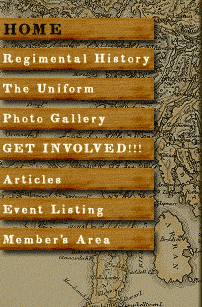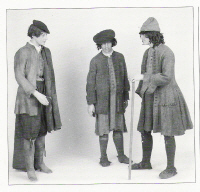| |
 |
 |
 |

|
|
 |
 |
 |
 |
|
 |
 |
 The Highland Bonnet is an item of pride for Scots.
The Highland Bonnet is an item of pride for Scots.
|
 |
 |
|
|
|
The Highland Bonnet
By Stephen Belyea
The Highland bonnet is one of the symbols of Scotland, like the kilt, that is recognized around the world. It is however, an item of dress that has a long history. The bonnet was always a covering for a man’s head. The term was originally the name for the material used in the making of this headgear. The flat knitted Scottish bonnet more than likely developed from the cloth or knitted caps worn by men of western Europe in the 16th Century.The Oxford English Dictionary states that the cap replaced the bonnet in England but was retained in Scotland (sometimes called a Scotch Cap).

Many articles of clothing have been preserved on bodies that were berried in peat bogs.These bodies, some two or three hundred years old have been invaluable to historians. To the right is an image of this excavated clothing now on display in the National Museum of Scotland.
Below are three period examples of early Scottish caps from the National Museum of Antiquities of Scotland. The historian John Telfer Dunbar describes them a follows: “The first came from Dara Moor in Morayshire and is knitted, and an unusualunusual feature is the two strings, one on each side, which were tied under the chin. The second cap or bonnet was dug up in Tarvie in Ross-shire and to is knitted, in this case in green wool. It has little slits just below the edge of the crown into which a brooch could have been fitted. The third specimen, excavated at Barrock, in Caithness, is made of dark brown cloth. This one has a small triangular vent in the head-band at the back which has been overlapped to fit the wearer and then stitched up.”(1)

Dunbar also describes one of the Bog Bodies: “Amongst the items of clothing belonging to a young man who died in the early 18th Century, and who’s body was excavated on the Isle of Lewis, was his bonnet. It had been knitted with several needles in order to achieve its circular form, then shrunk and felted. Having been dyed with indigo, it was probably dark blue originally, and the head band was decorated with little knots of red wool.”(2) It has been suggested that this style of decoration may have been the start of the diced bonnet which appear in the late 1750’s
Bonnet making was originally a cottage craft. In the parish of Kilmarnock, in Ayrshire, by 1700 there were five incorporated trades one of them was bonnet making. The bonnet makers were the oldest of the trades and takes its incorporation date as 1646. Many Scottish regiments of the American Revolution list Kilmarnock caps/ bonnets as part of their regimental inventory. It seems that the town’s name became an identifier as to a particular style of bonnet, more than likely a military blue bonnet diced with red and white with green or blue accent squares.
The military bonnet of the 18 th Century has a form of construction not unlike some of the early excavated examples. The bonnet maker would first select wool yarns of proper weight and then test the yarn for colorfastness and rate of shrinkage. A pattern was then developed which was worked up on multiple needles. This pattern would yield a massive bonnet that would cover both head and chin. The bonnet was then placed in boiling water. The hot water caused the wool to shrink. The bonnet was then placed in cold water shocking the wool. After which the bonnet was then placed on a form and brushed into shape. As the bonnet dried the wool tightened and became “felted”. This process was at first trial and error. The first production bonnets were often wrong in some way, the blue tops could be too big or the dicing too small. Corrections to the pattern would be made and the maker would start again. Once the form was right production could start in earnest. Each maker would produce a bonnet that would be presented to a regimental agent who would in turn present it to a regimental officer for inspection. If approved this would be a “sealed pattern” to which all the bonnets would conform.
|
|
 |
 |
 |
 |
|
|
 |
|
|

















